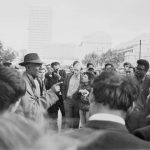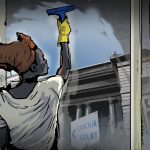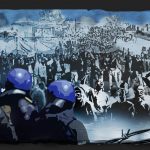From the Archive | The black trade union movement
In 1986, academic and activist Steven Friedman charted the rise to prominence of workers’ movements, wondering if unions could become laboratories for democracy.
Author:
7 March 2019

Steven Friedman’s essay, The Black Trade Union Movement, first appeared in Apartheid in Crisis alongside other contributions by, among others, Nadine Gordimer, JM Coetzee, Nelson Mandela, Desmond Tutu, and Cyril Ramaphosa.
This is an edited extract from Apartheid in Crisis edited by Mark A Uhlig, and published by Penguin Books in 1986.
Labour journalists used to call it the “solidarity syndrome”. In late 1980, political commentators and journalists discovered South Africa’s black trade union movement and began to beat a path to its door, seeking similarities between it and Poland’s Solidarity. But when they found the unions were not about to overthrow apartheid, they soon turned their attention elsewhere.
Today, the syndrome lives again. In December 1985, the unions formed a new superfederation, the Congress of South African Trade Unions (Cosatu), which represents some 500 000 workers, a dues-paying membership far in excess of any of the militant anti-apartheid membership groups. Its president, mine clerk Elijah Barayi, immediately committed it to campaign against racial laws, and once again the unions were seen as a central threat to white supremacy.
As in 1980, this development highlights a truth but distorts it, too. The growth of the union movement is an important political development with implications for the style, tactics and goals of black efforts to win change. The way in which the government was forced to accommodate the unions also says much about reform in an apartheid society, and some white reformers increasingly see changes in the mines, shops and factories as a model for wider political change.
Labour power
But the union movement cannot of itself end apartheid. Its more experienced leaders do not expect it to, and, if black activists or political observers look for it to lead a challenge to white power, they will again be disappointed. Unionised workers may well play a vital role in change, but, paradoxically, they are likely to do this only if their unions do not mount the frontal assault on white power that black nationalists expect and white supremacists fear.
Little more than a decade ago, black workers were powerless, subservient cogs in the white industrial machine. A rigid racial policy barred them from taking part in the economy, except as unskilled labourers. The law excluded them from skilled jobs, and so they had little bargaining power: because workers had no skills, employers could fire them when they organised and replace them quickly. The pass laws barred many black workers from the cities unless they worked for a particular employer, and to lose a job often meant losing the prospect of finding another. Black unions were not outlawed, but the law did not guarantee them bargaining rights: employers ignored them and arrested their members if they went on strike.
Related article:
But in the late 1960s, employers found they could not meet their labour needs in a growing economy if they relied only on non-black workers. They began using blacks in more skilled jobs, which other races would not accept, and the government began to encourage them to train clerks. While black workers still could not compete with other races for jobs – they could fill only those that other non-blacks vacated – this was a first recognition by the white establishment that black workers were no longer dispensable.
In 1973, the white establishment was jolted when tens of thousands of black workers in the port city of Durban went on strike in support of wage demands. The strikes spread to other cities, and the year saw more labour unrest than any other since World War II. Previously, employers would simply have fired the strikers and the police would have arrested them. This time, however, most employers offered the striking workers small wage increases and the police did not act against them. The then prime minister, John Vorster, castigated employers for paying poverty wages and urged them to see their black workers as “human beings with souls”.
Since black workers had become more important elements in the nation’s labour pool, their strikes could no longer simply be crushed. In an attempt to prevent fresh unrest, the government and employers encouraged black workers to use workplace committees to express grievances. The committees were weak and ineffective, as they were firmly controlled by the employers and were seen as a substitute for, not a precursor to, fully fledged unions. But they offered trade unionists and black workers an opening they soon exploited.
Unionism reborn
The strikers also prompted the rebirth of black unionism. Black workers had been forming unions since 1919, but successive waves of labour organisation had been crushed. In the early 1970s a small group of unionists and student activists had begun to organise black workers again, but they had little effect: the 1973 unrest was a spontaneous reaction to the workers’ economic plight, not a sign of organisation. Still, it gave workers new confidence, and thousands began joining the new unions, particularly in Durban. The unions recruited some 40 000 members in a matter of months, only to decline swiftly in the face of a recession and police action against unionists.
For the rest of the decade, the new union movement struggled on in virtual obscurity. Despite their shock at the appearance of the 1973 strikes, employers and the government still sought to thwart black unionism: employers repeatedly fired unionised workers, and the government used security laws against unionists and encouraged employers to resist the unions. The unions suffered repeated setbacks and numbered their members in hundreds, not thousands.
But it was in this lonely period that today’s union movement was forged. The small work organisation bodies that were formed then later became the nucleus of union groups – the Federation of South African Trade Unions (Fosatu), the Council of Unions of South Africa (Cusa), the General Workers Union (GWU) – which led work actions in the 1980s.
The unions were too weak to recruit a mass following, so they concentrated instead on making gains in individual factories. Because they had no legal rights, their only resource was the unity and commitment of their members. The unions told workers they could advance only through collective efforts and began to train them in the leadership skills they would need to resist their employers’ attempts to break the union movement. Because the strategy relied on worker unity, factory leaders would have to be controlled by their followers, and union officials stressed grass-roots democracy as much for its tactical as for its moral value.
Organising for democracy
A new style of black organisation began to grow in the factories. It stressed tight grassroots organisation and democracy – and stressed also that compromises were advances rather than defeats. For decades, powerless blacks had not believed that they could change their world, and they had longed for some political messiah who could do it for them. The unions, in contrast, told workers they could take charge of their own lives and working conditions.
Throughout the 1970s, the government and employers tinkered with the committee system in an attempt to neutralise black unionism but failed to eliminate the movement. The skills shortage grew. Black workers became less dispensable and gained new skills that made it more difficult for employers to fire them. A handful of foreign-owned companies, responding to pressure in their home countries, began to bargain with the unions, giving them a permanent base in some factories. By 1979, the government was forced to accept the inevitable: it adopted the report of an official inquiry, the Wiehahn Commission, which urged that racial job bars be scrapped and that black unions be granted legally sanctioned bargaining rights.
Related article:
But this reform, too, sought to control black worker power. The unions would enjoy official bargaining rights only if they registered with the government. Registered unions had to accept some government control and were barred from political involvement. They would have to bargain through official industrial councils that seemed designed to cut them off from their factory power base. They could strike only if they followed cumbersome procedures that made legal stoppage difficult or impossible. The reforms thus allowed unions to operate but denied them real power.
Instead of controlling workers, the reforms ushered in a period of sustained factory unrest: by 1984, in the midst of a crippling recession, official strike figures broke the record set in 1973. The factory organisation and the tactical suppleness the unions had developed in the 1970s allowed them to make their gains.
Demanding rights
The unions used their new power to gain something that blacks had always been denied: a share in decisions that affect their lives. First, they challenged the employers’ right to set their pay alone. They demanded a “living wage”, and, after some bitter factory battles, many employers were forced to concede it. Then, as the economy declined, they fought arbitrary firings.
In the 1970s, tens of thousands of black workers were fired and banished to jobless rural backwaters on a day’s notice, some simply because they were worker leaders. Then many employers found they could fire workers only if they applied standards demanded by the unions: job preference for longer-serving workers, compensation for fired workers and greater decision-making power. Unionised workers sought – and sometimes won – a say in areas where employers had taken unilateral decisions for decades, such as health and safety or working women’s rights.
Related article:
To many outsiders, this change did little to dent apartheid. African workers might have won some factory rights, but they were still subject to unfettered white power outside the workplace. The unions might be strong in many factories, but they lacked industry-wide and national influence. They had won rights for only a fraction of working blacks and could not aid the millions of unemployed.
But the change was profound. Blacks not only had won a say in the decision that had always been the sole preserve of whites, but had done so through the collective efforts of ordinary black people rather than by following a few high-profile leaders. They had developed a new kind of black leadership: workers with little formal education were now bargaining with sophisticated white management – and often outmaneuvering them. They relied on grass-roots support, thus rendering themselves less vulnerable to government action and compromise.
After the fall of apartheid
It is significant that union members sought to influence community groups, for this acknowledged unions could not in themselves lead the fight for change; their goal was both less and more ambitious. Unions still insisted that their chief role lay in the factories where they could build the skills and confidence that the workers needed to fight for political change. The training this provided could allow them to play a role in the political groups that were better equipped to challenge apartheid directly. But their strategy also sought not only to strengthen the fight against apartheid but also to influence its strategies and goals, and hence to determine the kind of society that would emerge when racial supremacy ended.
From the outset, the unions have been committed to more than simply replacing the white government. Their goal is to win rights for their worker members, and this implies full social as well as racial equality, not a society in which a white elite is replaced by a black one. Workers, the unions argue, should influence political groups not only to insure that the tactics of those groups are more effective and that they recognise worker needs, but union movement, in particular the stress on grass-roots democracy, are carried over into a new society. Unions cannot be “laboratories for revolution”, for they are open, legal organisations; nor can they be political parties, for their members have a variety of political views. But they can be “laboratories for democracy”, training grounds in a type of grass-roots democratic politics that could not only challenge apartheid but help shape the society that replaces it.
Related article:
The unions are a power in many factories and industries, but they have not yet developed the national muscle that would enable them to challenge the government. They have proved the value of tight grassroots organisation, but, if they opt for pass protest politics, they are certain to sacrifice elements of the organisation – and to be weakened in the process.
It is far too early to begin writing obituaries for the unions’ unique attempt to inject a new dimension into black politics. Their bargaining rights are only six years old, and many workers are only now beginning to apply the new style of organisation in factories. It may be years before “mandate politics” becomes so ingrained it can mount an effective challenge to the populist style of many black nationalist groups.
Its prospects depend partly on imponderables: if black nationalists gain power within, say, five years, the unions’ style of politics may well prove too new and partial a phenomenon to influence the new society. If, as seems more likely, the battle for political power is protracted, organised workers could have a decisive effect on the nature of change. “Workers who have been wielding power in the factories for 20 years won’t surrender it to any government, black or white,” said one unionist.
The unions’ growth is not only a challenge to white power. It also provides the white establishment with the prospect of a relatively peaceful transition to an egalitarian society. Only if whites grasp the opportunity will South Africa have a chance of escaping the cycle of violence that now grips it.




